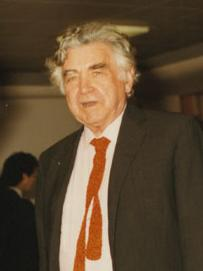
Rodrigo Moynihan
Rodrigo Moynihan was a British painter renowned for his contributions to abstract art in England. Born on October 17, 1910, in Santa Cruz de Tenerife, Canary Islands, Moynihan's career spanned several decades and was marked by significant innovations in painting, including his involvement in the Objective Abstraction movement and his work as an acknowledged war artist.
Biography of Rodrigo Moynihan
Rodrigo Moynihan was born to an English father and a Spanish mother. The family relocated to London in 1918 and later to Wisconsin. Inspired by a winter in Rome in 1927-1928, Moynihan began studying at the Slade School of Fine Art in London in 1928. He gained prominence in the 1930s as a key figure in the Objective Abstraction movement, which emphasized the material aspects of painting and was a precursor to Abstract Expressionism.
During World War II, Moynihan served in the British Army and worked as a camouflage specialist before being nominated as a war artist by the War Artists' Advisory Committee (WAAC). After the war, he was appointed Professor of Painting at the Royal College of Art and later became a recognized member of the Royal Academy. He transitioned between abstraction and figuration throughout his career, eventually returning to figurative painting in the 1970s.
Rodrigo Moynihan's Famous Paintings
"The Shelf, Objects and Shadows - Front View" (1982-83) is one of Moynihan's notable works from his later years. This painting exemplifies his return to still life, featuring painter's tools arranged in an unstructured manner. The work is celebrated for its exploration of natural light and unarranged objects, capturing a sense of spontaneity and authenticity. Moynihan used oil paint to achieve the vibrant and dynamic interplay of light and shadow.
Rodrigo Moynihan's Art Style
Rodrigo Moynihan's art style reflects a dynamic evolution from abstraction to figuration, marked by his pioneering contributions to Objective Abstraction and his later engagement with still life and portraiture.
In the 1930s, Moynihan emerged as a key figure in the Objective Abstraction movement. This movement focused on the inherent qualities of the painting medium itself, emphasizing painterly strokes and the material properties of paint. Moynihan, alongside artists like Ivon Hitchens and William Coldstream, explored the limits of abstraction by creating works that highlighted the texture and physicality of paint. His early abstract works were characterized by their vibrant colors, dynamic brushwork, and a focus on the interplay of light and shadow. This approach was a precursor to Abstract Expressionism and was noted for its intense use of color and form, which David Gascoyne famously described as an "explosion in a jam factory."
During and after World War II, Moynihan's style shifted towards social realism and figuration. His wartime work, including official portraits and camouflage designs, reflected a focus on representational accuracy and the human element. As a war artist, he created portraits of military figures and scenes of wartime life, which were marked by their realism and emotional depth. After the war, Moynihan became famous for his official portraits, including those of notable figures such as Princess Elizabeth and Prime Minister Clement Attlee. These portraits demonstrated his skill in capturing the personality and status of his subjects through a more traditional, realistic style.
In the late 1950s, Moynihan returned to abstraction, reflecting his restless nature and desire for continuous innovation. His later abstract works, especially those from the 1970s onwards, reintegrated elements of abstraction into his practice. During this period, Moynihan focused on creating large-scale studio still lifes, characterized by their seemingly unordered and random arrangement of objects. These still lifes, such as "The Shelf, Objects and Shadows - Front View" (1982–83), demonstrate a return to the exploration of light and the natural placement of objects. Moynihan deliberately avoided arranging objects into a formal composition, allowing them to "arrange themselves" in the light. This approach emphasized the spontaneity and naturalism of the scene, aligning with his broader exploration of abstraction.
Moynihan employed various techniques till the end of his career. His abstract works often featured thick, expressive brushstrokes and a rich palette of colors, while his figurative and portrait work was marked by precise detailing and careful rendering. His later still lifes used oil paint to capture the interplay of light and shadow, reflecting his interest in the materiality of painting and the natural world.
His art was influenced by a range of styles and movements, including Post-Impressionism and Cubism, which informed his early abstraction. The transition from abstraction to figuration and back again reveals Moynihan's engagement with the evolving trends of 20th-century art while maintaining a unique and personal approach to painting. His work remains notable for its ability to bridge different styles and techniques, demonstrating a continuous dialogue between abstraction and representation.
Notable Exhibitions and Legacy
Rodrigo Moynihan's work has been showcased in prominent galleries such as the Redfern Gallery and the Hanover Gallery in London, and the Charles Egan Gallery and Robert Miller Gallery in New York. His paintings are part of significant collections, including the Tate, the Royal Academy of Arts, and the Imperial War Museum. Moynihan's contributions to art have been recognized for their innovative approach and lasting influence on both abstract and figurative painting.
Years:
Born in 1910
Country:
United Kingdom, London